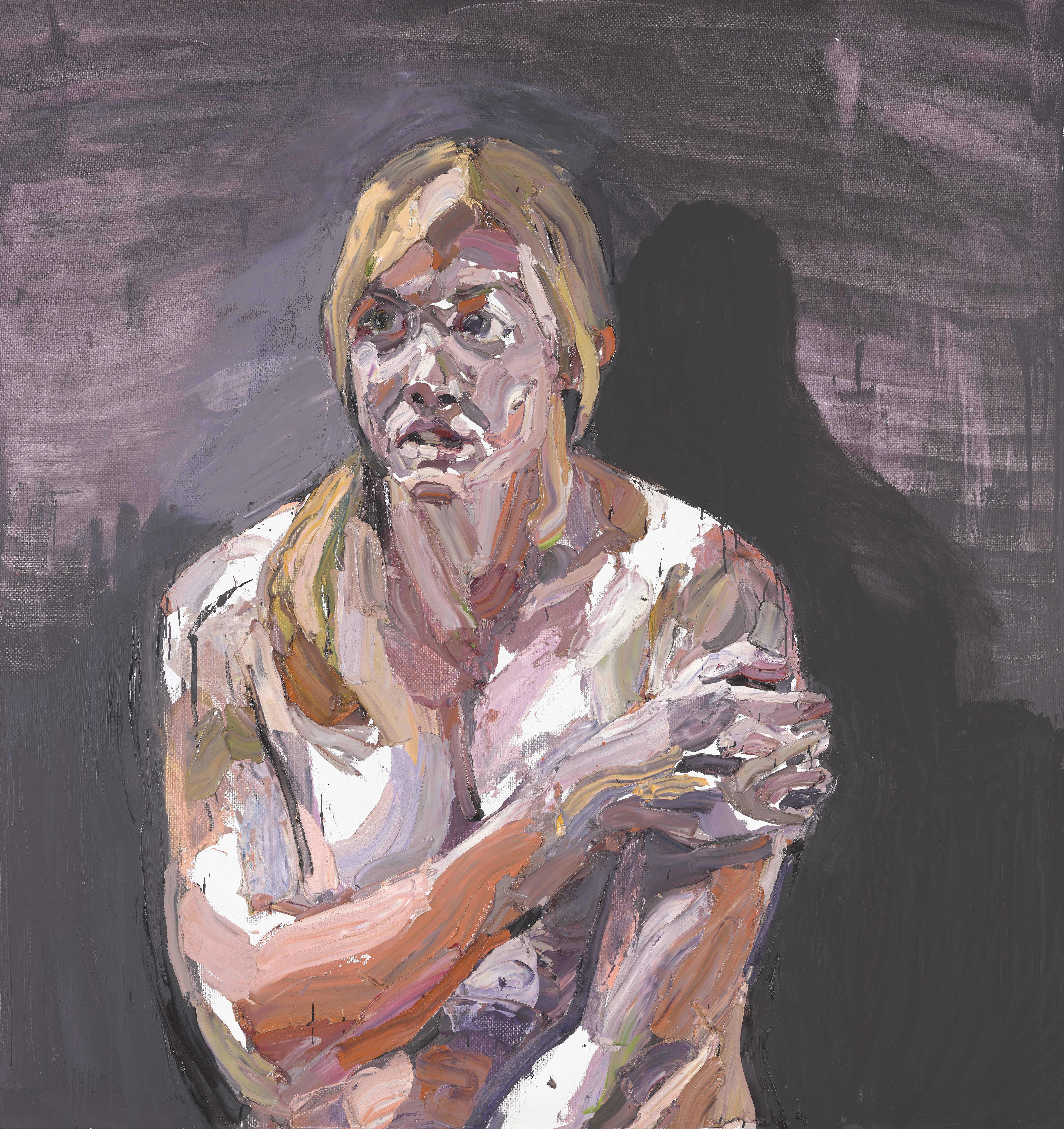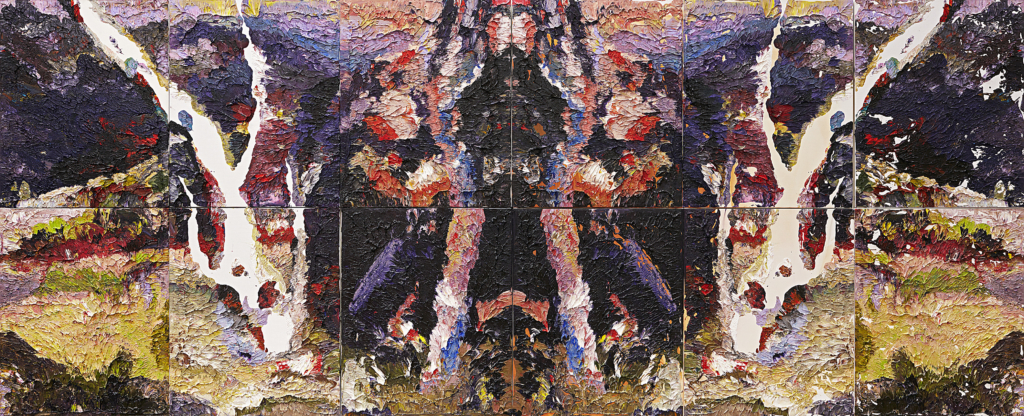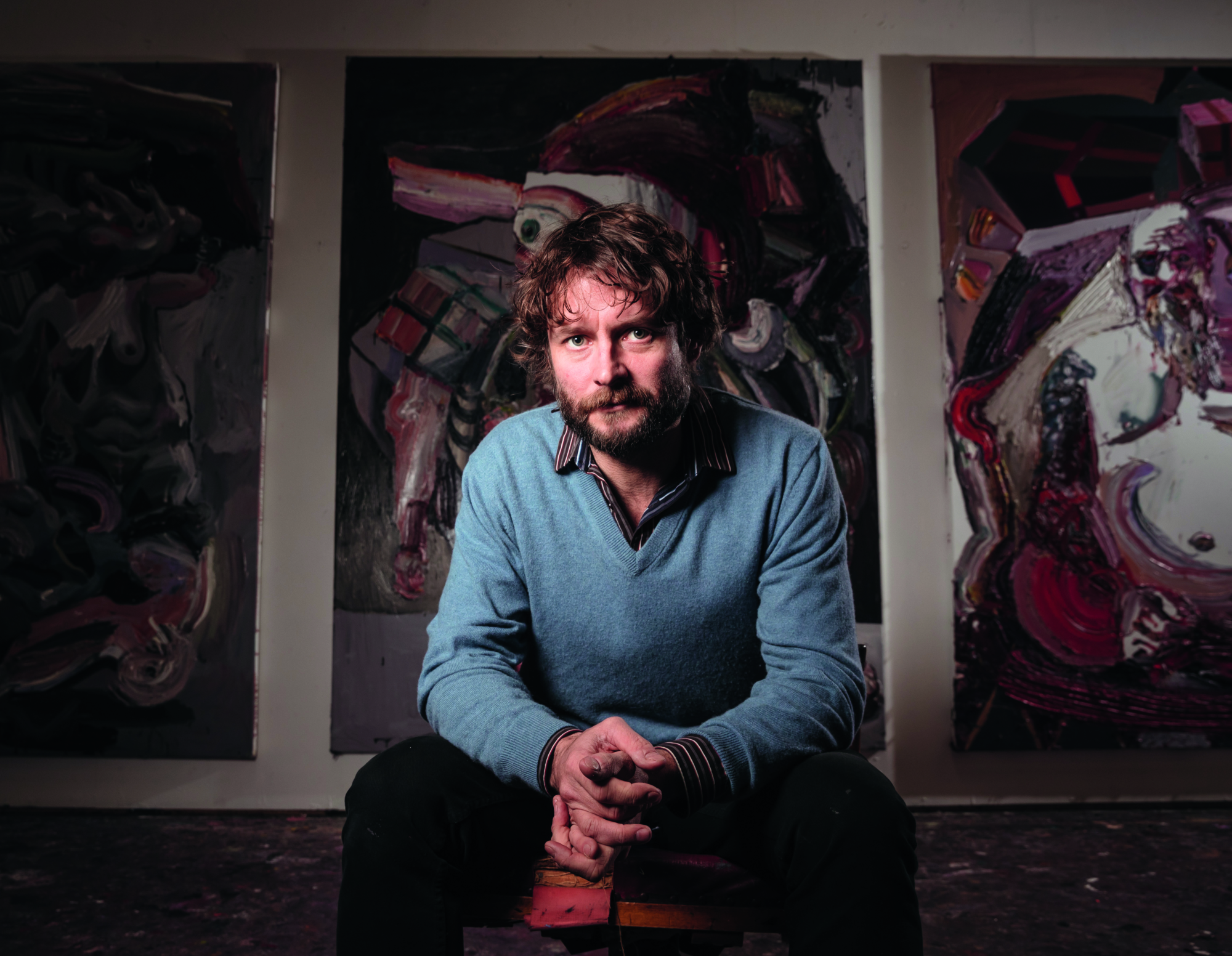After profiling such personalities as Aussie photographer Trent Parke, Spitting Image co-creator Roger Law and overlooked Australian impressionist painter John Russell – among others – documentarian Catherine Hunter has turned her attention to the well-known and subversive painter Ben Quilty. Rather than another probing expose of its titular subject, Quilty: Painting the Shadows reveals the often-overlooked practical methodology to his intricate artistry, including his efforts to depict the 1838 Myall Creek massacre, in which twenty-eight people of the Wirrayaraay tribe were brutally murdered by stockmen at Myall Creek Station.
I talk to Hunter about the importance of authenticity when documenting a creative process; how the film organically developed into something more than just a profile on Quilty; and the ultimate irrelevance of impartiality in documentary making.
Oliver Pfeiffer: Considering he’s a talent who’s already been covered quite extensively in the media, what was the impetus for exploring Ben Quilty?
Catherine Hunter: There wasn’t anything that concentrated on Ben actually creating the work. If you can spend time in an artist’s studio, it’s a very privileged opportunity. Ben was initially quite reluctant, [but] I think [because] we were a very small crew of two people, after a while he actually forgot we were there, and it just allowed us to film the process.
Most paintings these days are ‘raw sharks’: those multi-panelled canvases stuck together and pulled apart. To see that process is really illuminating, and to hear why he likes working like that and that element of chance that creeps in […] I’ve worked with many artists over the years, and I [have] often found that they’re at their most articulate and revealing when they’re actually working. Rather than doing a formal sit-down interview, you have them making the art so they’re thinking less about what they’re saying and more about how they’re making it. Ben of course has probably had more exposure than any other artist in Australia. However, I think it’s been a fairly fractured coverage of his career to date.

You successfully capture that authenticity of the artist at work. Can you tell me about the practical struggles involved in achieving that?
When you’re making a film about an artist, you can’t ask them to do something again. You can’t ask them to pick up that paintbrush again or paint that bit of canvas again. You would lose all respect and patience for the process. I have an amazing cameraman, Bruce Inglis, [who is] very unobtrusive – so if he misses a shot he wanted, well, that’s okay; there’ll be something else. We’ve been covering artists for over thirty years in this country, and we know what to ask and what not to ask [them]. I think that’s very important. At first, [Ben] didn’t want to film in the studio, but I think he realised after a while he could forget about us. It was only after he started working on the major painting that we feature in the film [a representation of the Myall Creek massacre] that he said, ‘I can’t have you here when I start that painting.’ So that’s when we agreed that I could leave a GoPro there, and, when he felt inclined, he would turn it on.
Was there any aspect of Quilty’s life that you were either reluctant to cover or that he specifically asked you not to delve into?
No, I think once Ben says ‘yes’, he really respects you and what you’re doing, whether you’re a photographer, a cameraman or a journalist – keeping in mind that he came out of Channel Seven, where he was an editor[1]Quilty worked at Channel Seven for five years as a film editor covering news and current affairs. […] He never asked to see the film, and he never [imposed] any restrictions upon me.
Quilty is renowned for channeling all of the anger directly into his work, revealing a deeper, more complex truth. Do you feel he’s quite fearless?
I think he does feel that he has to give voice to [subjects] he feels strongly about. It’s [mentioned] in the film [that Quilty’s mentor] Margaret Olley just wanted him to paint beautiful paintings, and he could paint very beautiful landscapes and sell them. He could paint Torana cars and sell hundreds of them, because everyone wants Torana cars, but he’s not going to keep doing that. I think he has to paint what moves him. He’s not impervious to criticism, and I think it does hurt him […] but it’s not going to stop him doing what he does.

One of Quilty’s biggest triumphs is exploring the dark underbelly of contemporary Aussie masculinity.
That’s his world, so he feels he can comment on it. When it comes to other subjects, I think he seeks permission or makes sure it’s okay to go down [into] other areas, but when he’s painting about his own life, everything is fair game.
Considering the confronting times we’re living in, do we need Quilty more than ever, to shake things up and to question what’s happening?
I think the great thing is he’s touched something. How many painters have really touched a [broad] audience? Margaret Olley did, but who else? I think therein lies his problem, because everybody wants a bit of [him]. Everybody wants him to help raise money to do this and that, and he tends to say ‘yes’ too often. It’s hard being Ben Quilty.
‘I’ve worked with many artists over the years, and I [have] often found that they’re at their most articulate and revealing when they’re actually working.’
— Catherine Hunter
And he also has this willingness to open up about everything – even that provocative 2019 Good Weekend cover saga.[2]Quilty was photographed wearing a crown of barbed wire for the cover of The Sydney Morning Herald’s Good Weekend magazine. For the original article and photograph, see Brook Turner, ‘Ben Quilty on the Burden of Being Australia’s Artist from Central Casting’, Good Weekend, 23 February 2019, <https://www.smh.com.au/entertainment/art-and-design/ben-quilty-on-the-burden-of-being-australia-s-artist-from-central-casting-20190219-p50ypb.html>; and for an example of the criticism the artist received as a result of this image, see Eugene Yiu Nam Cheung, ‘The Canonisation of Quilty’, Running Dog, 5 March 2019, <https://rundog.art/the-canonisation-of-quilty/>, both accessed 6 May 2020.
It’s something that a lot of people remember, therefore it had to be addressed in a way; but I also think it belongs to [that] year. Ben doesn’t think he’s Jesus Christ or a ‘Messiah’ figure; but when [a] photographer asks him to do something, he generally agrees without thinking about the ramifications. This is because he respects the artist. In that case, the photographer was the artist.
What do you want people to take away from the documentary?
I hope what they take away is an insight into how those paintings are made, and I hope they take away some Australian history that not enough is known about. So many people came up to me at the end of the [premiere screening[3]The premiere screening was held on 12 October 2019 at the Queensland Art Gallery & Galley of Modern Art (QAGOMA) as part of the Brisbane International Film Festival.] to say they were going to go to the Myall Creek Memorial next year[4]A commemoration ceremony is held at the Myall Creek Memorial site annually on the second Sunday of June. – and, like myself, I don’t think many people [previously knew] the details of that. If you start to read about the court case and what happened, it’s a story that we should all be aware of. At Newcastle University at the moment, they’re mapping the massacres [of Indigenous people in Australia], and I think they’re up to about 250. Myall Creek represents a lot of those because there was so much written about it and it was so well documented. In the end, I think the film is not just about Ben and Ben’s art practice; I think [it is] trying to shed light on something else.

Myall Creek ends up becoming the main thrust of the documentary, with Ben’s artistic depiction of the site of this very dark Australian chapter. When did you know you had that?
He wanted to paint it. His father had talked about Myall Creek, and Ben had never been [to the site] before and wanted to go there. Obviously, you have to have permission from the elders to make such a painting – they’ve got to believe that you’re doing it for the right reasons. So it happened very late in the day. The film was pulled together very quickly.
If you didn’t have that particular aspect, what would you have focused on?
With every documentary, you take a risk. You just have to hope things will work out. I wouldn’t have had the film that I got. It would probably have been more of a film about Ben Quilty. But I think it’s about Ben Quilty’s interpretation of Myall Creek, and therein lies, hopefully, its importance. Mark Tedeschi wrote in his book Murder at Myall Creek[5]Mark Tedeschi, Murder at Myall Creek, Simon & Schuster, Sydney, 2016. that – paraphrasing – often you can do so much more with a painting than you can in words, and, if your painting ends up in a public gallery, people can actually go and see it and talk about it and think about it. That’s the power of the film, I hope.

You mentioned during a Q&A[6]Held at QAGOMA following the premiere screening. that the ABC had originally voiced concerns that you weren’t impartial enough. Do you feel there should there be a level of impartiality as a documentary maker?
I think critical analysis, if it sheds light on your subject, can be important, but not criticism for the sake of it. [Ben] does divide people. Do I think that the Good Weekend saga is relevant? I don’t know, but I know that it drew a lot of social media attention because it was interpreted in a certain way. I do think that we’re too quick to criticise in this country. I don’t think, for the most part, that I have criticism for the sake of criticism in the documentary. What do you criticise? The paintings?
I don’t think we get a sense of our artists for years, possibly until they’re no longer alive. How do you judge a painting, and what are we judging? Are we judging a person’s character, or are we judging the painting? A painting is a personal thing. You have critics out there who think some of Ben’s work is fantastic, [but] perhaps don’t like other works; there’ll be other critics [who] don’t like his work at all. What are we judging?
For me, the fact that there were strong female Indigenous voices and non-Indigenous voices gave [the documentary] balance. What people kept saying to me was, ‘What Ben does is he gives a voice [to] people who often don’t have a voice’ […] If he’s giving a voice to those people, that’s great. I’m not a critic. That’s not my role. My role is to take a story out there, and hopefully people watch it and take something away from that. My role as a documentarian is not to say it’s good or bad.
And you’re making art accessible, as well. I went into the Quilty exhibition[7]A 2019 exhibition of the artist’s work developed by the Art Gallery of South Australia; see ‘Quilty’, Art Gallery of South Australia website, <https://www.agsa.sa.gov.au/whats-on/exhibitions/quilty/>, accessed 6 May 2020. before and after I saw the documentary, and, understandably, was able to better appreciate it the second time around.
So many people say [they] wished they’d seen the film before they’d gone into the exhibition, because you do get a different sense. It’s about knowing the stories [behind the paintings]. Ben is telling us history and he’s telling us stories, and there are many layers to it. So an exhibition will often trigger a film, and then I like people to go and see the work. I was lucky that Painting the Shadows [aired] on ABC the week after [the exhibition] opened at the Art Gallery of New South Wales. So there is a direct link, and we have a fantastic, reactive audience in this country.
Endnotes
| 1 | Quilty worked at Channel Seven for five years as a film editor covering news and current affairs. |
|---|---|
| 2 | Quilty was photographed wearing a crown of barbed wire for the cover of The Sydney Morning Herald’s Good Weekend magazine. For the original article and photograph, see Brook Turner, ‘Ben Quilty on the Burden of Being Australia’s Artist from Central Casting’, Good Weekend, 23 February 2019, <https://www.smh.com.au/entertainment/art-and-design/ben-quilty-on-the-burden-of-being-australia-s-artist-from-central-casting-20190219-p50ypb.html>; and for an example of the criticism the artist received as a result of this image, see Eugene Yiu Nam Cheung, ‘The Canonisation of Quilty’, Running Dog, 5 March 2019, <https://rundog.art/the-canonisation-of-quilty/>, both accessed 6 May 2020. |
| 3 | The premiere screening was held on 12 October 2019 at the Queensland Art Gallery & Galley of Modern Art (QAGOMA) as part of the Brisbane International Film Festival. |
| 4 | A commemoration ceremony is held at the Myall Creek Memorial site annually on the second Sunday of June. |
| 5 | Mark Tedeschi, Murder at Myall Creek, Simon & Schuster, Sydney, 2016. |
| 6 | Held at QAGOMA following the premiere screening. |
| 7 | A 2019 exhibition of the artist’s work developed by the Art Gallery of South Australia; see ‘Quilty’, Art Gallery of South Australia website, <https://www.agsa.sa.gov.au/whats-on/exhibitions/quilty/>, accessed 6 May 2020. |





